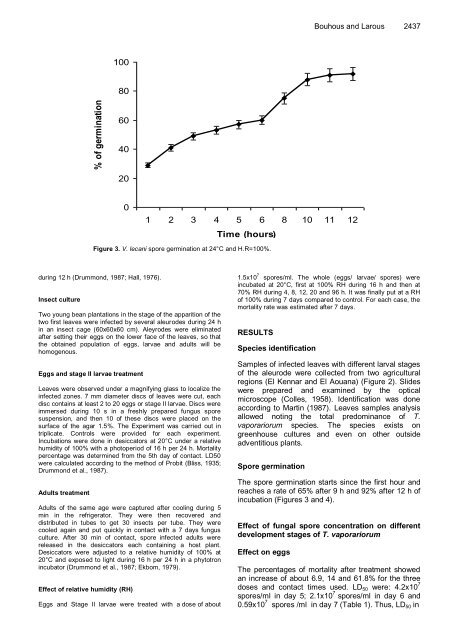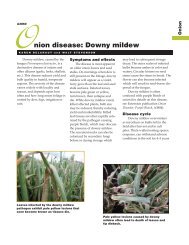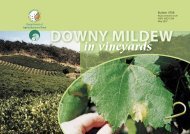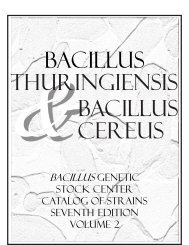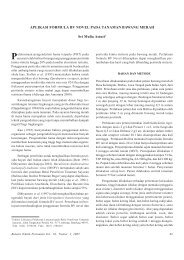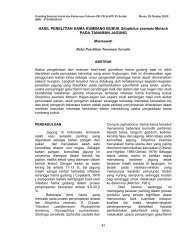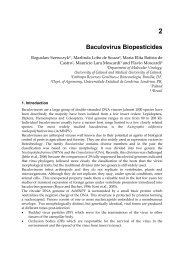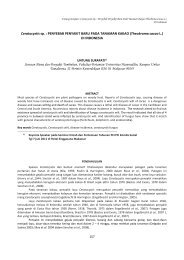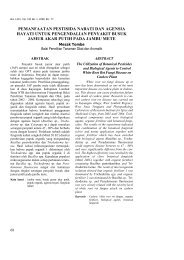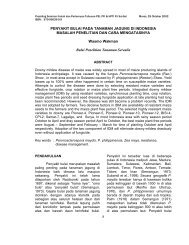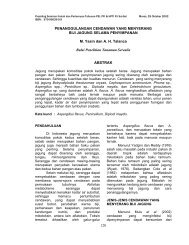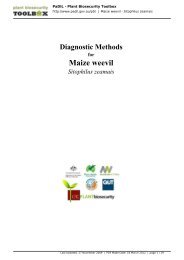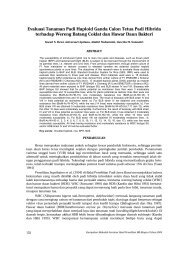Efficiency of the entomopathogenic fungus Verticillium lecanii in the ...
Efficiency of the entomopathogenic fungus Verticillium lecanii in the ...
Efficiency of the entomopathogenic fungus Verticillium lecanii in the ...
You also want an ePaper? Increase the reach of your titles
YUMPU automatically turns print PDFs into web optimized ePapers that Google loves.
% <strong>of</strong> germ<strong>in</strong>ationBouhous and Larous 24371008060402001 2 3 4 5 6 8 10 11 12Time (hours)Figure 3. V. lecani spore germ<strong>in</strong>ation at 24°C and H.R=100%.dur<strong>in</strong>g 12 h (Drummond, 1987; Hall, 1976).Insect cultureTwo young bean plantations <strong>in</strong> <strong>the</strong> stage <strong>of</strong> <strong>the</strong> apparition <strong>of</strong> <strong>the</strong>two first leaves were <strong>in</strong>fected by several aleurodes dur<strong>in</strong>g 24 h<strong>in</strong> an <strong>in</strong>sect cage (60x60x60 cm). Aleyrodes were elim<strong>in</strong>atedafter sett<strong>in</strong>g <strong>the</strong>ir eggs on <strong>the</strong> lower face <strong>of</strong> <strong>the</strong> leaves, so that<strong>the</strong> obta<strong>in</strong>ed population <strong>of</strong> eggs, larvae and adults will behomogenous.Eggs and stage II larvae treatmentLeaves were observed under a magnify<strong>in</strong>g glass to localize <strong>the</strong><strong>in</strong>fected zones. 7 mm diameter discs <strong>of</strong> leaves were cut, eachdisc conta<strong>in</strong>s at least 2 to 20 eggs or stage II larvae. Discs wereimmersed dur<strong>in</strong>g 10 s <strong>in</strong> a freshly prepared <strong>fungus</strong> sporesuspension, and <strong>the</strong>n 10 <strong>of</strong> <strong>the</strong>se discs were placed on <strong>the</strong>surface <strong>of</strong> <strong>the</strong> agar 1.5%. The Experiment was carried out <strong>in</strong>triplicate. Controls were provided for each experiment.Incubations were done <strong>in</strong> desiccators at 20°C under a relativehumidity <strong>of</strong> 100% with a photoperiod <strong>of</strong> 16 h per 24 h. Mortalitypercentage was determ<strong>in</strong>ed from <strong>the</strong> 5th day <strong>of</strong> contact. LD50were calculated accord<strong>in</strong>g to <strong>the</strong> method <strong>of</strong> Probit (Bliss, 1935;Drummond et al., 1987).Adults treatmentAdults <strong>of</strong> <strong>the</strong> same age were captured after cool<strong>in</strong>g dur<strong>in</strong>g 5m<strong>in</strong> <strong>in</strong> <strong>the</strong> refrigerator. They were <strong>the</strong>n recovered anddistributed <strong>in</strong> tubes to get 30 <strong>in</strong>sects per tube. They werecooled aga<strong>in</strong> and put quickly <strong>in</strong> contact with a 7 days <strong>fungus</strong>culture. After 30 m<strong>in</strong> <strong>of</strong> contact, spore <strong>in</strong>fected adults werereleased <strong>in</strong> <strong>the</strong> desiccators each conta<strong>in</strong><strong>in</strong>g a host plant.Desiccators were adjusted to a relative humidity <strong>of</strong> 100% at20°C and exposed to light dur<strong>in</strong>g 16 h per 24 h <strong>in</strong> a phytotron<strong>in</strong>cubator (Drummond et al., 1987; Ekbom, 1979).Effect <strong>of</strong> relative humidity (RH)Eggs and Stage II larvae were treated with a dose <strong>of</strong> about1.5x10 7 spores/ml. The whole (eggs/ larvae/ spores) were<strong>in</strong>cubated at 20°C, first at 100% RH dur<strong>in</strong>g 16 h and <strong>the</strong>n at70% RH dur<strong>in</strong>g 4, 8, 12, 20 and 96 h. It was f<strong>in</strong>ally put at a RH<strong>of</strong> 100% dur<strong>in</strong>g 7 days compared to control. For each case, <strong>the</strong>mortality rate was estimated after 7 days.RESULTSSpecies identificationSamples <strong>of</strong> <strong>in</strong>fected leaves with different larval stages<strong>of</strong> <strong>the</strong> aleurode were collected from two agriculturalregions (El Kennar and El Aouana) (Figure 2). Slideswere prepared and exam<strong>in</strong>ed by <strong>the</strong> opticalmicroscope (Colles, 1958). Identification was doneaccord<strong>in</strong>g to Mart<strong>in</strong> (1987). Leaves samples analysisallowed not<strong>in</strong>g <strong>the</strong> total predom<strong>in</strong>ance <strong>of</strong> T.vaporariorum species. The species exists ongreenhouse cultures and even on o<strong>the</strong>r outsideadventitious plants.Spore germ<strong>in</strong>ationThe spore germ<strong>in</strong>ation starts s<strong>in</strong>ce <strong>the</strong> first hour andreaches a rate <strong>of</strong> 65% after 9 h and 92% after 12 h <strong>of</strong><strong>in</strong>cubation (Figures 3 and 4).Effect <strong>of</strong> fungal spore concentration on differentdevelopment stages <strong>of</strong> T. vaporariorumEffect on eggsThe percentages <strong>of</strong> mortality after treatment showedan <strong>in</strong>crease <strong>of</strong> about 6.9, 14 and 61.8% for <strong>the</strong> threedoses and contact times used. LD 50 were: 4.2x10 7spores/ml <strong>in</strong> day 5; 2.1x10 7 spores/ml <strong>in</strong> day 6 and0.59x10 7 spores /ml <strong>in</strong> day 7 (Table 1). Thus, LD 50 <strong>in</strong>


